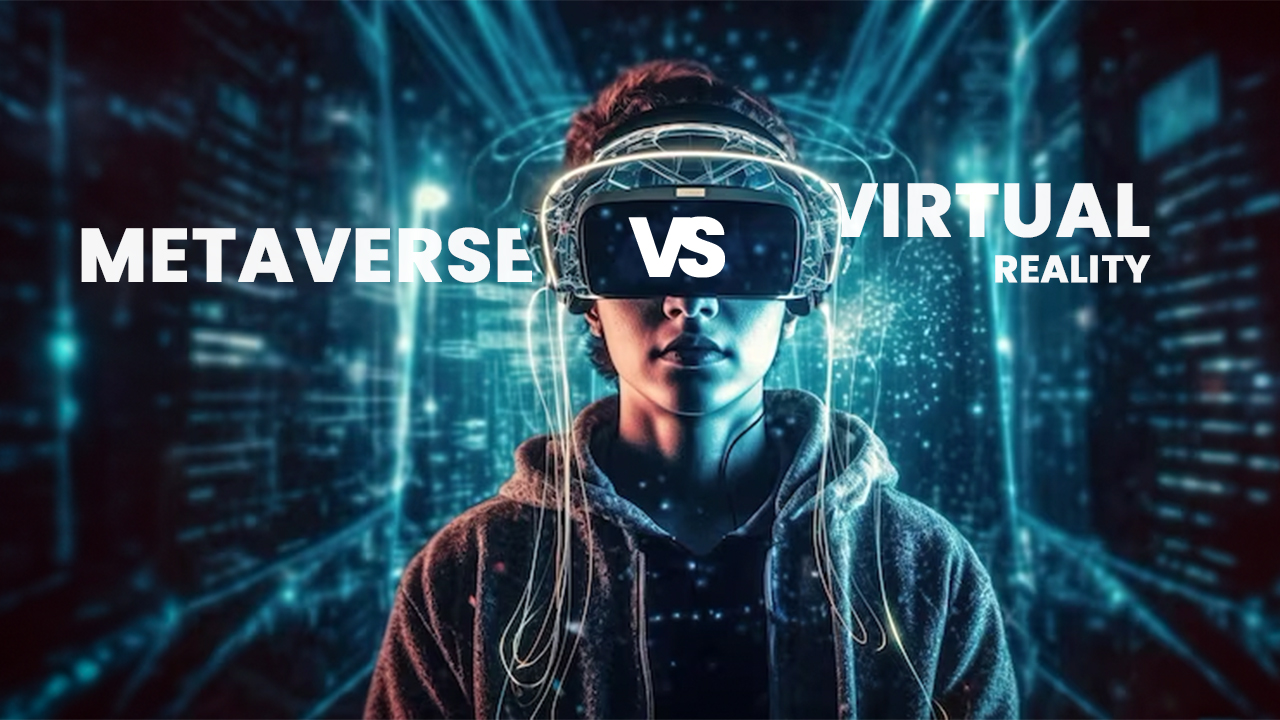The kingdom of finance, digital innovation, and our tangible existence are becoming increasingly intertwined. With the simple press of a button, the technologies we engage with exert substantial influence over our daily lives, affording us access to nearly everything we desire.
The Metaverse stands as a revolutionary technology that promises to immerse users in a genuinely virtual world, offering an expansive array of experiences.
You might question, “Haven’t we already encountered this through Virtual Reality?” While it might appear like a virtual realm, the Metaverse and Virtual Reality diverge significantly. Here’s an in-depth comparison to delineate the distinctions between the two.
What is Metaverse?
The Metaverse is a term that describes a collective virtual shared space, created by the convergence of virtually enhanced physical reality and physically persistent virtual reality.
In simpler terms, it’s a vast, interconnected digital universe where individuals can interact, work, play, and socialize in real-time.
This concept, often associated with sci-fi and virtual reality, represents a fully immersive digital world that goes beyond traditional 2D internet experiences.
It’s not just about playing games or socializing; rather, it’s a multifaceted space where people can engage in various activities, such as attending events, buying virtual property, conducting business, attending classes, and much more.
Explained in Technopedia, the idea of the Metaverse involves the use of virtual reality, augmented reality, and other technologies to create an expansive, shared digital environment that blurs the line between the digital and physical worlds.
Companies are exploring ways to develop and integrate such environments to offer users a more interactive, immersive, and interconnected experience beyond what we typically encounter on the internet.
Pros & Cons
The Metaverse presents incredible potential for innovation and transformative experiences, yet it also poses challenges that need careful consideration and strategic solutions for a more inclusive and secure digital landscape.
Pros of Metaverse Technology
Unleashing Creativity and Innovation: The Metaverse offers a boundless canvas for creativity and innovation. Businesses can leverage this technology to craft immersive, interactive experiences, from virtual storefronts to engaging product showcases, fostering new ways to captivate and connect with their audience.
Enhanced Customer Engagement: Through these unique, immersive experiences, companies can deeply engage their customers, fostering stronger relationships and loyalty. The ability to create tailored, memorable interactions within the Metaverse can significantly impact consumer interest and brand attachment.
Workplace Evolution: The Metaverse revolutionizes the concept of work arrangements by erasing geographical barriers. Teams can collaborate seamlessly in virtual meeting spaces, transcending physical boundaries, enabling efficient work dynamics and diverse collaborations.

Cons of Metaverse Technology
Substantial Investment Requirements: Establishing a presence in the Metaverse demands substantial financial investments. This encompasses the costs of technology development, ongoing platform maintenance, and the need for comprehensive employee training, which can be a significant financial burden.
Data Privacy and Security Challenges: Given the vast volumes of sensitive user data involved, concerns surrounding data privacy and security become paramount. Safeguarding this information within the Metaverse environment is a crucial yet complex challenge for businesses and technology providers.
Digital Disparities: The accessibility of Metaverse technology isn’t universal, leading to a digital divide. This means that not all customers or employees have equal access to or benefit from engaging with Metaverse experiences, potentially perpetuating inequalities in user experiences and opportunities.
What is Virtual Reality?
Virtual Reality (VR) is a computer-generated simulation or recreation of an environment that allows users to interact and be immersed in a seemingly real, three-dimensional world.
It often involves the use of a headset or other devices that cover the user’s eyes and ears, providing an artificial but convincing sensory experience.
VR technology aims to create an environment that simulates the physical presence in places, whether real or imaginary, allowing users to interact in that environment.
By wearing a VR headset, users are visually transported to a different space, and often with the aid of controllers or other devices, they can engage and manipulate elements within that artificial world.
The primary goal of VR is to provide an immersive experience that tricks the brain into believing that the user is present in a different environment, creating a feeling of being “inside” the simulated world.
This technology finds applications in various fields such as gaming, entertainment, education, training, healthcare, and even in architecture and design, offering a new way to experience and interact with digital content.
Pros & Cons
Virtual Reality (VR) is a groundbreaking technology offering immersive experiences and innovative applications across various domains. However, its drawbacks, including cost barriers and some other existing challenges in this evolving technological landscape.
Pros of Virtual Reality Technology
Engrossing Experiences: Virtual Reality (VR) provides an unparalleled level of immersion that surpasses any other medium. By synchronizing our senses, it crafts a compelling illusion, making users feel seamlessly integrated into a completely different world.
Innovative Applications: From gaming and cinematic experiences to educational and professional training, VR is revolutionizing how we absorb information, perform tasks, and entertain ourselves.
Fostering Empathy: By enabling users to step into another person’s virtual shoes, VR cultivates empathy and understanding, serving as a catalyst for social and cultural awareness.
Cons of Virtual Reality Technology
Cost Barrier: The high-quality VR headsets and the necessary hardware can be financially prohibitive, potentially restricting access for many users due to the associated expenses.
Health Considerations: Extended usage of VR may lead to issues like motion sickness, eye strain, and disorientation. Moreover, there is a risk of physical injury if users navigate unsafe physical spaces while engrossed in a VR experience.
Technological Challenges: Despite advancements, VR grapples with challenges such as resolution limitations, latency issues, and providing convincing tactile feedback. These limitations can occasionally disrupt the sense of immersion that VR aims to deliver.
Metaverse Vs Virtual Reality: Key Differences
The comprehensive analysis of the metaverse and virtual reality serves as a foundational framework for delineating a comparison between the two. Discussions about the metaverse frequently intertwine with discussions on VR, blurring the distinctions. However, despite the apparent similarities, both stand significantly apart. Here, we spotlight the primary disparities between the metaverse and virtual reality.
Ownership
The major difference between the metaverse and virtual reality is about who owns what. In virtual reality (VR), the brand owns all the content and experiences you use on their system. You only own the equipment.
But in the metaverse, it’s different. You get to own things like virtual property or objects you create or buy. Everything in the metaverse is yours, giving you complete ownership and control over what you make or acquire.
Technologies
While comparing the metaverse to virtual reality, a crucial aspect is the limitations in technology. Virtual Reality (VR) has its restrictions—it’s mainly about creating refined virtual experiences, continuously improved within VR systems. It’s focused on simulations and enjoying adventures in a virtual space.
Contrastingly, the metaverse doesn’t face these limitations. It isn’t solely reliant on VR tech. Instead, it harnesses diverse technologies like AR, blockchain, crypto, and connectivity tools. Most notably, the metaverse is an extensive virtual world open to integrating new tech for enhanced functionalities.
Experience
When we compare the metaverse to VR, how you encounter these virtual realms is key. With VR, you’re aware of wearing a headset or gadget to enter the virtual world, but the experiences are often confined to a limited number of users, such as gamers.
In contrast, the metaverse offers a virtual universe akin to the real world by blending AR and VR technologies. This allows you to navigate virtual realms much like you move in the physical world, albeit through a digital avatar. Crucially, experiences in the metaverse aren’t restricted to specific spaces. The distinction in quality of experiences between the metaverse and VR underscores how the metaverse enables users to visit, explore, and connect with other users and varied spaces within this expansive digital realm.
Persistence
Distinguishing between the metaverse and virtual reality, persistence plays a pivotal role. In the comparison of virtual reality versus the emerging metaverse, VR systems stand out as a popular choice for experiencing virtual worlds. Yet, VR experiences cease once the system is turned off.
Contrastingly, the metaverse presents a paradigm shift in terms of persistence, offering a shared and enduring universe. Even after exiting the metaverse, your digital avatar remains, continuing to exist and interact with other users in the metaverse. This continuous presence sets the metaverse apart, highlighting its persistence compared to the more limited duration of experiences in VR systems.

Practical Applications Of VR & Metaverse
The application of VR and the Metaverse technology is significantly transforming the business landscape. Various sectors are utilizing these technologies to create distinctive, immersive experience for both their customer and employees.
Take Walmart, for instance, using VR for employee training, simulating scenarios like the Black Friday rush and customer service situations. Real estate companies like Zillow leverage VR to provide virtual home tours for potential buyers to explore properties from their homes.
Pioneering the metaverse, companies like Roblox and Epic Games craft expansive virtual worlds for users to play, socialize, and attend events. Facebook, now Meta, is heavily investing in constructing a comprehensive metaverse, albeit facing certain challenges.
Globally recognized brands like IKEA use VR to offer customers virtual tours of room designs, enhancing shopping experiences. In the automotive sector, Ford utilizes VR in the design process, allowing engineers to inspect and modify car models virtually before manufacturing.
The gaming industry, spearheading the metaverse, is showcased in games like Minecraft, providing users with extensive, user-generated metaverse experiences for creating and exploring virtual worlds. These applications illustrate a future where people can work, learn, play, and socialize in a shared immersive digital space.
Real-world examples display how VR and metaverse technologies are reshaping business operations, presenting fresh opportunities for growth and innovation. These instances highlight the integration of VR and metaverse technologies into various business models, molding the future of industries.







